Not Llama. LAMA.

Om mani padme hum… the Green Lama strikes, for Justice!
The Green Lama, a Westerner who wears the robes of a Tibetan Buddhist monk, recently returned to the public eye as one of the mysterious protagonist in the Dynamite Entertainment comic series, PROJECT: SUPERPOWERS. Although the concept of the series is well publicized, the use of characters whose copyrights have slipped into the public domain, few people know the full history of the individual characters. Today I decided to research The Green Lama, who has one of the most varied of these histories, which ran from the pulp magazines, to comics, to radio, and back to comics.
In the early part of the twentieth century, the reigning form of magazine entertainment was not to be found in the illustrated books known as comics, but in larger, inexpensive fiction magazines known as pulps. These pulp magazines consisted of slick, high gloss covers wrapped around cheap wood pulp paper and were sold much cheaper than the family oriented magazines of the day. At ten-cents, you could purchase approximately one hundred and thirty pages of fiction stories designed to thrill, often to the disappointment of parents. These pulp magazines ranged in fare from lurid love stories, to hard-boiled detective fiction, to science and fantasy and more. Despite being purchased by people of all ages and classes, the pulps where generally considered “trash†by the respected literary groups of the day.
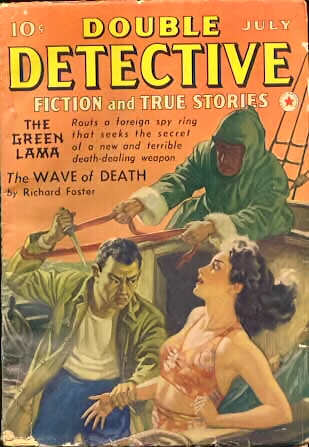
In the 1930’s, the king of the pulp world was Street and Smith and their character, The Shadow, was the most popular mystery man on the shelves. In an effort to boost sales, author/editor Kendall Foster Crossen was asked by the publisher of Double Detective Magazine, Frank Munsey, to create a new character to compete with Street and Smith’s favorite son. The result was The Green Lama, a Tibetan Buddhist hero who made his first appearance April 1940 in issue number 5, volume 5 of DOUBLE DETECTIVE.
The Green Lama stories, written by Crossen under the alias Richard Foster, continued to appear in DOUBLE DETECTIVE until 1943. They were and are considered a success, just not as big a success as THE SHADOW series, but very strong. In the pulp stories, wealthy New Yorker Jethro Dumont spends ten years in Tibet learning the philosophy of Buddhism and eventually is rewarded by being made a Lama. While there, he learns not only the ways of the Lama, but many mystic and scientific secrets, such as radioactive salts, which give him super powers. He would solve crimes ranging from kidnapping to murder and broke crime rings like many of his contemporaries, but he did it with insight, often quoting Buddhist parables and sayings. In an odd twist, Jethro Dumont not only had the secret identity as the crime fighter The Green Lama, but he also was known as the Buddhist priest Dr. Pali. Select stories from this era of the Green Lama’s career are available for purchase, in reprints, in a magazine called HIGH ADVENTURE.
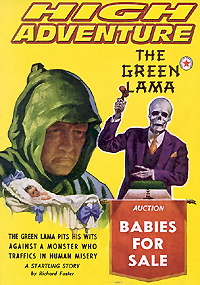
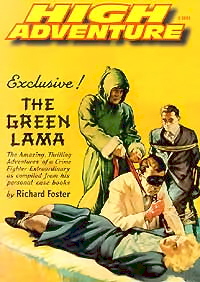
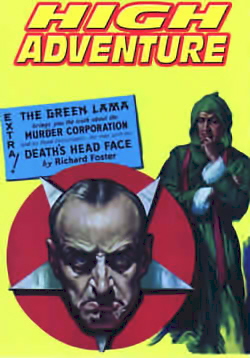
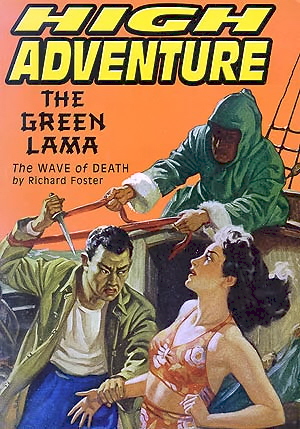
Toward the end of 1940, the Green Lama made his jump from pulp fiction to the world of comics. By some coincidence, this was the same year that Street and Smith began publishing THE SHADOW comic. His first appearance was in Crestwood Publications’ PRIZE COMICS #7, December 1940. He appeared in approximately twenty-seven issues of PRIZE COMICS before receiving his own self-named title over at Spark Publications. This version of The Green Lama lasted eight issues, spread out from 1944 to 1946.
Despite still being written by his creator, Kendall Foster Crossen, the comic version of The Green Lama had several noted differences from the pulp version. First, his costume changed from a more monastic, green robe to a skin tight green outfit complete with matching boots and hooded cape. He also gained super strength and the power of flight in the comic version. It should be noted that, at one point, he did use his mantras to call up the spirits of dead heroes to fight for him. He often employed various mantras to call up these powers, much in the spirit of Fawcett’s Captain Marvel. Drawing the adventures of Jethro Dumont and his manservant was the legendary Emanuel “Mac†Raboy, of Captain Marvel Junior and later Flash Gordon fame. Crossen and Raboy teamed up for all of The Green Lama’s comic book adventures. An interesting note, The Green Lama participated in one of the earliest crossovers: In PRIZE COMICS #24 The Green Lama, Yank And Doodle, Black Owl and Dr. Frost, and teamed up to defeat the Frankenstein Monster!
The Green Lama’s publication timeline shows how resilient the character has been. He was featured in the pulp magazines for 14 issues over 3 years, from 1940 to 1943. His appearances in PRIZE COMICS also lasted almost three years, late 1940 to 1943. In the October 1943 issue of PRIZE COMICS, #35, he was replaced by The Flying Fist and Bingo, ending his first comic run. For many characters their shelf life would have ended there, but over a year later in 1944 Sparks Publications began THE GREEN LAMA series for eight issues. Those ended in March of 1946.
“Okay, so now the character is dead, right?”
Wrong.
Three years later, June 5th, 1949, THE GREEN LAMA radio show hit the airwaves with the first episode, The Case of the Man Who Never Existed. Once again, the character was treading ground which had already been conquered by his competitor, The Shadow. In each episode, Dumont’s manservant Tsarong would retell an adventure of The Green Lama. Paul Frees, whose most famous role was probably as the voice of Boris Badenov, was the voice of Jethro Dumont. Despite being excellently produced shows with adventurous scripts, THE GREEN LAMA radio show lasted for only eleven episodes. The last episode, The Case of the Perfect Prisoner, aired on August 20th, 1949, a scant three months after the first episode aired. There are only four of these original shows are believed to have survived, and a fifth, The Case Of The Lady In White, was recreated in 1997 at the Friends Of Old Time Radio Convention by The Gotham Radio Players. The four original episodes and the one recreation are readily available on the internet and are well worth a listen.
“So, that’s it right?”
Wrong again!
In 1964, comic publisher Israel Waldman began reprinting Golden Age comics, and The Green Lama was among the ones he reprinted. It should be noted that this was interesting at the time, because the super hero was just beginning to come back into vogue and Waldman did not own any of the publishing rights to the characters he reprinted!
Once the character fell into the public domain, publisher AC Comics used the character in many stories for his classic (and still being published) series, FEMFORCE. These original works where the first since 1946. In 2004, writer/artist James Ritchey III announced that he was going to be creating a new series called THE GREEN LAMA: MAN OF STRENGTH. Unfortunately, for various reasons, Mr. Ritchey was forced to shelve this series until recently.
UPDATE: After this article original went live, I received an e-mail from AC Comics publisher Bill Black. He was kind enough to give me just a little more information regarding his company’s history with the Green Lama.
Mr. Black states that The Green Lama not only appeared in AC Comics series FEMFORCE (one of the longest running independent series in comic history), but that they have reprinted Green Lama stories from both Prize and Sparks. Their title MEN OF MYSTERY featured Green Lama on at least one cover, and he has been featured in at least that at least 35 different AC Comics!
In March of 2008, GREEN LAMA: MAN OF STRENGTH #0 was published by AC Comics, and Mr. Ritchey’s issue #1 was to hit the shelves April of this year. There is even a MySpace page promoting the series under the member name greenlamalives. At the MySpace page, you can watch a short trailer promoting the new AC series, and even listen to the surviving radio shows. I was lucky enough to read Mr. Ritchie’s first issue on his ComicSpace page and I have to say I enjoyed it. Essentially, you have the grandson of Jethro Dumont finding that he is a reincarnation of his own grandfather, and is intended to inherit The Gift. The story takes place in darker alternate version of the standard AC Comics Universe, and actually made me want to not only find the Green Lama books but to check out some other AC books as well.
Last year (2007 for those of you reading this entry from the far future), comic creators Jim Krueger and Alex Ross announced that The Green Lama would be one of many public domain characters to be used in their limited series PROJECT: SUPERPOWERS from Dynamite Entertainment. This version has been the most widely publicized, and is sure to add to the long legacy of the Green Lama. Their version shows a Green Lama who has retired to a Tibetan monastery and is called upon by one of his old partners to help correct a situation which lead to the “deaths†of all of their old teammates. Here, the Green Lama has retained his health and gained even greater magical prowess, including plant control. He seems at times to be slightly aloof, but this seems to be a Yoda-esque cover for his real power. Both series are defiantly worth a look.
As if two new series aren’t enough to prove how resilient the Green Lama is, how about the offerings from Dark Horse Comics? They will be publishing two hardbacks containing reprints of the Green Lama stories published by Sparks as well as a collectible Classic Comic Book Characters statue, number seven in the series. The statue depicts the Golden Age costume of the Green Lama, while the hardbacks are a chance to own some great story telling by Crossen and some seldom seen art by the legendary “Mac†Raboy. The Green Lama even went digital, as he and his fellow heroes Swift Arrow and Atoman make an appearance in the cell phone comic by Donald Jackson called SPARKS COMICS ALL-STAR ADVENTURES available at ROK Comics online.
An interesting note: The original Green Lama stories where lauded for their attention to detail regarding the Buddhist faith. Even the mantra which the Green Lama chants, sometimes to get some power and sometimes to simply focus, is a true mantra. Om mani padme hum is a six syllable chant which invokes Meditation, Patience, Discipline, Wisdom, Generosity and Diligence. Whenever Crosse was asked about his attention to the Buddhist faith in Green Lama stories, he would often reply that it was simply that he had decided to make a Tibetan Buddhist character and did the research to make sure that he got it right. That attention to detail, as well as the excellent art by Emanuel “Mac†Raboy, laid the ground work for future success.
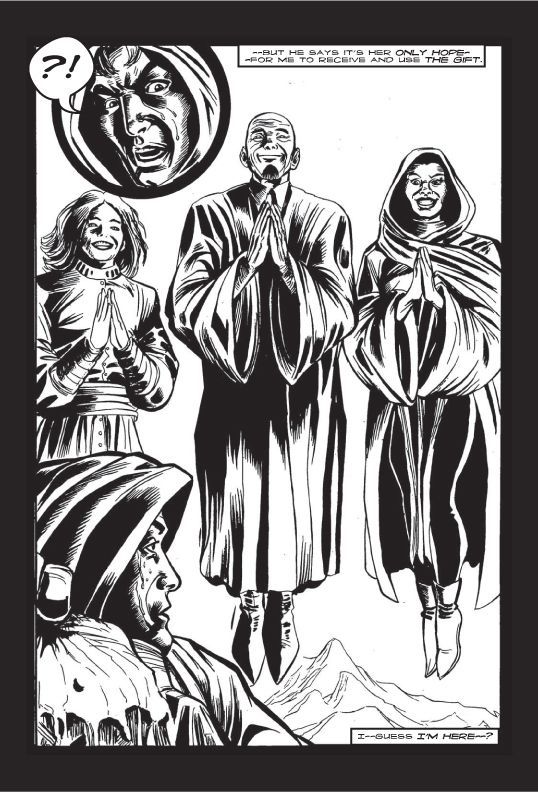
What is it about the Green Lama that has helped him to survive for so long without any “big†exposure? I like to think that it is the care and attention that the original creators gave it, and word of mouth of people discovering the character in so many different mediums that enabled his survival. I strongly encourage you to check out any one of the projects with the Green Lama. Be it the AC Comics series, the Dynamite Entertainment Series, the Dark Horse reprints, or even just streaming or downloading an episode or two of the radio show, I don’t think that you will be disappointed. If you feel like taking some time to discuss the Green Lama, or any other character, come on over to the Major Spoilers Forum. It’s a great place with some great people.
Till next time, this is Stacy W. Baugher, signing off.



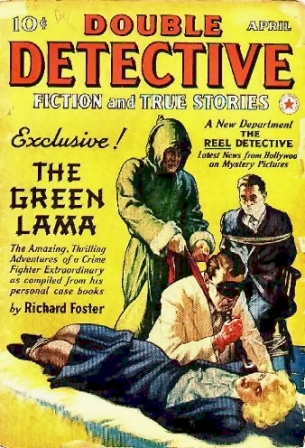
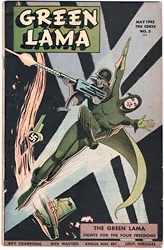





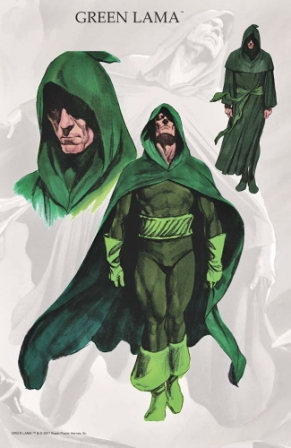

9 Comments
nice work
This AM NOT a Legion of Super-Hero?!
I am interested in this character being a curious non-Buddhist and recovering Catholic.
Thanks for the info on Green Lama.
Thanks ya’ll.
No, Green Lama isn’t a Legion character, but I thought that it might me an interesting little diversion to look at the publication history of a character that is being published in 2 different series, from different publishers, with a history as old as this one.
Thanks to Stephen and the rest of the guys for posting it up. I got more in mind, and they may be more main stream and known.
I got more in mind, and they may be more main stream and known.
Why? Half the point of the Hero History is to cover things that most readers won’t have been exposed to. Jethro Dumont is one of the most fascinating characters in the AC Comics lineup, and his Golden Age adventures have been almost criminally ignored…
I want to see guys like Pyroman, The Eagle, War Nurse, and Rainbow Boy get their day in the sun, dammit!
Okay! Okay! I guess I could start work on the Black Hood story or the Spirit Of ’76!
Gee whiz, Matt! Twist my arm why don’t you! LOL.
There is one major current character that I definately want to do, but that is gonna be a pretty big one. The guy has been in comics, radio, newspapers and recently toys, been published by at least 4 different publushers, and has proven to be a favorite with at least 3 different people using his name.
Got to leave you wanting more! ;-)
War Nurse… I got to remember that one.
Nice coverage on a little-known superhero of the Golden Age who could truthfully be called one of the inspirations for Marvel Comics’ Dr. Strange.
Seeing as how Jethro Dumont is supposed to be a Harvard graduate, I’d like to see the Green Lama go up against the pulp super-villain known as Dr. Death (formerly, Dr. Rance Mandarin, Yale psych professor)! Either in AC Comics or one of the Dynamite Entertainment mags.
I had listened to the couple radio dramas posted to YouTube, and in them, it would appear that Jethro DuMont’s dual identity as The Green Lama is publicly known. Has this ever been addressed in the character’s history?
The Green Lama character is not in the public domain. I own the copyright to the 14 original Green Lama pulp stories by my father, Kendell Foster Crossen, of which the comics and the radio scripts, etc., are all derivative. (The original 8 Spark comic books did go out of print and thus those particular comics are public domain, which is different from the character being public domain.)
My father believed that the most attractive feature of the character was the “mysticism” of the Tibetan Buddhist content, which in the 1940s was not well known in the US. Today Tibetan Buddhism is popular among Western students of Buddhism, who would recognize the many errors in the presentation of that tradition in these stories. (One example is that the Tibetan Buddhist literature is only in Sanskrit and Tibetan; the older language of the Buddha’s time, Pali, would not have been studied by a Tibetan monk.) The power of the Tibetan mantra is real, though!
Kendra Crossen Burroughs, book editor with specialty in Tibetan Buddhism